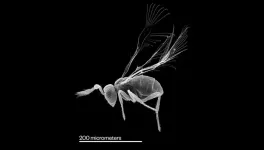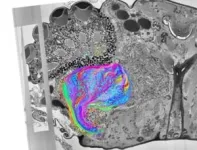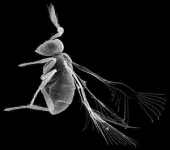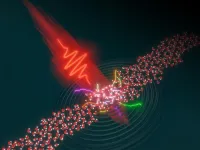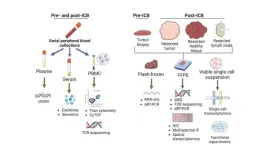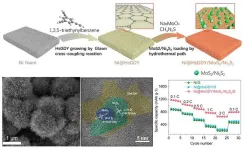(Press-News.org) Neuroscientists at the Flatiron Institute in New York City and their colleagues have made a big breakthrough using one of the world’s smallest brains.
Using an ion beam, an electron microscope and a lot of patience, the neuroscientists mapped out the entire early visual system — from the eyes that take in light to the neurons processing the information — for a parasitic wasp smaller than a grain of table salt. The feat marks the first time scientists have fully reconstructed such a system at the synaptic level from a single specimen of any animal species, the neuroscientists report online on September 29 in Current Biology.
While the tiny wasp has a minuscule brain (with just 8,600 cells compared to the typical human’s 171 billion), the itsy-bitsy insect is still capable of complex behaviors such as flight. “It’s incredible that there’s still so much complexity in such a small brain,” says study lead author Nicholas Chua, a former research analyst at the Flatiron Institute’s Center for Computational Neuroscience (CCN) who is now a Columbia University graduate student.
The wasp’s brain turned out to be “very similar to bigger brains, but simpler and smaller,” says study senior author Dmitri Chklovskii, a group leader at the CCN. The researchers are now mapping the wasp’s full brain, he says.
“The thought is that the principles by which the neurons and the neuronal circuits operate are the same between us and other animals,” he says, “and so that’s why we think that we can take what we learn from insects and apply it to the human brain.”
Understanding bug brains could also help researchers improve artificial intelligence tools, Chklovskii says. “When artificial neural networks were first created 70 years ago, they were inspired by the knowledge of neurons in the brain,” he says. “But our knowledge has progressed significantly since then. Capabilities of the human brain exceed that of artificial intelligence, and we know that it is built by different rules, so there must be some secret sauce that biology has that can help us build better AI.”
Chklovskii’s group at the CCN worked on the project in collaboration with the groups of Harald Hess of the Howard Hughes Medical Institute’s Janelia Research Campus and Alexey Polilov of Moscow State University.
Studying the most basic brains in the animal kingdom makes it easier to identify the mechanisms and rules that govern complex behaviors, Chklovskii says. The parasitic wasp Megaphragma viggianii is an ideal subject for such a task. This microscopic wasp is only around 200 micrometers long, but it can fly and seek out the eggs of insects called thrips, in which the wasps lay their own eggs.
The species had to shrink drastically to get that small: Some of the wasp’s cells even forgo nuclei to save space. Fruit flies, a favorite subject of biologists, are around 3,000 micrometers long and have more than 10 times as many cells in their brains as the wasps.
“A fruit fly is like an elephant compared to this,” Chklovskii says. “This whole creature fits into a fruit fly’s eye.”
The neuroscientists faced a major challenge when mapping out the entire early visual system from the fruit fly’s eyes all the way to the neurons that perform the initial visual processing. Previously, scientists used several different specimens to make such maps. That approach, however, meant that not everything matched up due to variations between the individual specimens.
Instead, the neuroscientists used just a single wasp. Its cells were too small to image using light, so they shot a beam of electrons at the insect and recorded how the electrons scattered. After each pass, the researchers used an ion beam to shave a thin layer off the insect, revealing a deeper level of the insect’s head.
Next, the researchers mapped out the wasp’s brain cells and the connections between them, called synapses. They had to do this mostly by hand, an incredibly laborious undertaking. (For future studies, they have begun implementing an AI-powered tool that speeds up the process.)
Using this method, the neuroscientists gained a greater appreciation for how the wasps see and process visual information. For instance, they discovered how different parts of the wasp’s eyes contribute to the creature’s vision and found that the wasps can detect the polarization of light — something not previously known about the species.
The next step for the neuroscientists is to map out the rest of the wasp’s brain to reveal the entire interconnected framework that the insect uses for complex behavior. “After that, we want to apply the principles that we will learn from these simpler, bare-bones systems to more complex brains like ours,” Chklovskii says.
The Flatiron Institute is the research division of the Simons Foundation. The institute's mission is to advance scientific research through computational methods, including data analysis, theory, modeling and simulation. The institute's Center for Computational Neuroscience develops models, principles and conceptual frameworks that deepen our knowledge of brain function — both in health and in disease.
END
Researchers create first-ever map of a single animal’s early visual system
Scientists have mapped out the entire early visual system — from eyes to neurons — for a tiny parasitic wasp, the first time such a system has been reconstructed at the synaptic level for a single specimen
2023-09-28
ELSE PRESS RELEASES FROM THIS DATE:
Study reveals more depression in communities where people rarely left home during the COVID-19 pandemic
2023-09-28
Key Takeaways
In a survey-based study of US adults, those living in communities in which most people seldom left home at certain times during the COVID-19 pandemic were more likely to report symptoms of depression
The link remained strong even after considering COVID-19 activity, weather, and county-level economics
Accounting for state-level pandemic restrictions only modestly attenuated the association
BOSTON – Higher levels of depressive symptoms have been reported during the COVID-19 pandemic compared with other times in history, and as much as three times higher than prior to the ...
Intense lasers shine new light on the electron dynamics of liquids
2023-09-28
An international team of researchers from the Max Planck Institute for the Structure and Dynamics of Matter (MPSD) in Hamburg and ETH Zurich has now demonstrated that it is possible to probe electron dynamics in liquids using intense laser fields and to retrieve the electron mean free path – the average distance an electron can travel before colliding with another particle. They found that the mechanism by which liquids emit a particular light spectrum known as the high-harmonic spectrum is markedly different from the one in other phases of matter like gases and solids. The team’s findings open the door to a deeper understanding of ultrafast dynamics in liquids.
Using ...
Study helps explain how COVID-19 heightens risk of heart attack and stroke
2023-09-28
In some patients, infection with the pandemic virus SARS-CoV-2 can trigger a dangerous immune response in hardened fatty deposits (plaques) lining the heart’s largest blood vessels, a new study shows.
The findings are based on the body’s immune system, which evolved to destroy invading microbes but also drives disease when triggered in the wrong context. Doing so brings on a set of responses termed inflammation, including swelling, which results as immune cells and signaling proteins home in on infection sites. ...
People who use alternative medicine favor risk and novelty, and distrust science
2023-09-28
Over 40 per cent of Canadians have used at least one risk-associated alternative health-care treatment in the past 12 months, says a new UBC study published in PLOS One.
The researchers explored alternative health-care therapies where the proven benefits do not justify the risks involved. They found that people who access these therapies tend to be wealthier, like novelty and taking risks, and are also more likely to distrust conventional medicine.
The multidisciplinary study between UBC School of Nursing and the University of Alberta Health Law Institute involved a survey of 1,492 Canadians ages 16 and over ...
SARS-CoV-2 infects coronary arteries, increases plaque inflammation
2023-09-28
SARS-CoV-2, the virus that causes COVID-19, can directly infect the arteries of the heart and cause the fatty plaque inside arteries to become highly inflamed, increasing the risk of heart attack and stroke, according to a study funded by the National Institutes of Health. The findings, published in the journal Nature Cardiovascular Research, may help explain why certain people who get COVID-19 have a greater chance of developing cardiovascular disease, or if they already have it, develop more heart-related complications.
In the study, researchers focused on older people with fatty buildup, known as atherosclerotic plaque, who ...
Immune checkpoint blockade prior to surgery promising in multiple cancer types
2023-09-28
Treating cancer with immunotherapies known as an immune checkpoint blockade (ICB) prior to surgery (so-called neoadjuvant immunotherapy) has been a rapidly growing area of research, but the scientific community is just scratching the surface of what is possible, according to a review article co-authored by several current and former investigators from the Bloomberg~Kimmel Institute for Cancer Immunotherapy and the Johns Hopkins Kimmel Cancer Center.
“We consider this approach to cancer immunotherapy to be a gold mine ...
HsGDY on Ni foam for loading MoS2/Ni3S2 to enhance the performance on lithium-sulfur batteries
2023-09-28
They published their work on Sep. 26 in Energy Material Advances.
"The booming progress of electric vehicles demands next-generation energy storage technologies with high energy density, low cost, and longevity." said Lu, a professor at the college of chemistry and chemical engineering in Shantou university. "Lithium-sulfur batteries are identified as a promising energy storage system because of their high ultrahigh energy density and large theoretical capacity. However, they are limited by the poor electronic conductivity of sulfur, volume changes of the cathode, and shuttle effect."
Lu explained that the conversion of polysulfides (Li2Sn, ...
Brief dialysis may be best for some kidney patients
2023-09-28
Patients with acute kidney injury requiring outpatient dialysis after hospital discharge receive the same care as those with the more common end-stage kidney disease, according to a study led by UC San Francisco.
But while patients with the latter diagnosis – typically caused by long-standing hypertension or diabetes – must remain on lifelong dialysis or receive a new kidney, some patients on dialysis for acute kidney injury have the potential to recover, the researchers reported in their study in the Journal of the American Society of Nephrology on Sept. 28, 2023.
“For ...
COOPERATE: Empowering minoritized patients with chronic back and other musculoskeletal pain to receive the care they need
2023-09-28
INDIANAPOLIS – A new study led by a U.S. Department of Veterans Affairs, Regenstrief Institute and Indiana University School of Medicine researcher focuses on empowering minoritized patients with chronic back and other musculoskeletal pain to receive care best suited to their individual values and preferences. Black patients continue to experience greater pain severity, worse pain outcomes and inadequate pain treatment compared to White patients, despite national priorities focused on health equity.
COOPERATE (Communication and Activation in Pain to Enhance Relationships ...
Novel battery technology with negligible voltage decay developed at CityU, a world’s first
2023-09-28
A pivotal breakthrough in battery technology that has profound implications for our energy future has been achieved by a joint-research team led by City University of Hong Kong (CityU).
The new development overcomes the persistent challenge of voltage decay and can lead to significantly higher energy storage capacity.
Lithium-ion batteries (LiBs) are widely used in electronic devices, while lithium-(Li) and manganese-rich (LMR) layered oxides are a promising class of cathodes for LiBs due to their high ...
LAST 30 PRESS RELEASES:
Researchers observe gas outflow driven by a jet from an active galactic nucleus
Pitt student finds familiar structure just 2 billion years after the Big Bang
Evidence of cross-regional marine plastic pollution in green sea turtles
Patients with clonal hematopoiesis have increased heart disease risk following cancer treatment
Stem cell therapy for stroke shows how cells find their way in the brain
Environment: Up to 4,700 tonnes of litter flows down the Rhine each year
Maternal vaccine receipt and infant hospital and emergency visits for influenza and pertussis
Interim safety of RSVpreF vaccination during pregnancy
Stem cell engineering breakthrough paves way for next-generation living drugs
California grants $7.4 million to advance gene-edited stem cell therapy for Friedreich’s ataxia
Victoria’s Secret grant backs cutting-edge ovarian cancer research
Research paves the way for safer colonoscopy bowel prep for people with compromised gut health
JMIR Publications and Sweden's National Library announce renewal and expansion of flat-fee unlimited open access partnership for 2026
A new 3D-printed solar cell that’s transparent and color-tunable
IV iron is the cost-effective treatment for women with iron deficiency anemia and heavy menstrual bleeding
Doing good pays off: Environmentally and socially responsible companies drive value and market efficiency
City of Hope and Cellares to automate manufacturing of solid tumor CAR T cell therapy
Short-circuiting pancreatic cancer
Groundbreaking mapping: how many ghost particles all the Milky Way’s stars send towards Earth
JBNU researchers propose hierarchical porous copper nanosheet-based triboelectric nanogenerators
A high-protein diet can defeat cholera infection
A more accurate way of calculating the value of a healthy year of life
What causes some people’s gut microbes to produce high alcohol levels?
Global study reveals widespread burning of plastic for heating and cooking
MIT study shows pills that communicate from the stomach could improve medication adherence
Searching for the centromere: diversity in pathways key for cell division
Behind nature’s blueprints
Researchers search for why some people’s gut microbes produce high alcohol levels
Researchers find promising new way to boost the immune response to cancer
Coffee as a staining agent substitute in electron microscopy
[Press-News.org] Researchers create first-ever map of a single animal’s early visual systemScientists have mapped out the entire early visual system — from eyes to neurons — for a tiny parasitic wasp, the first time such a system has been reconstructed at the synaptic level for a single specimen
